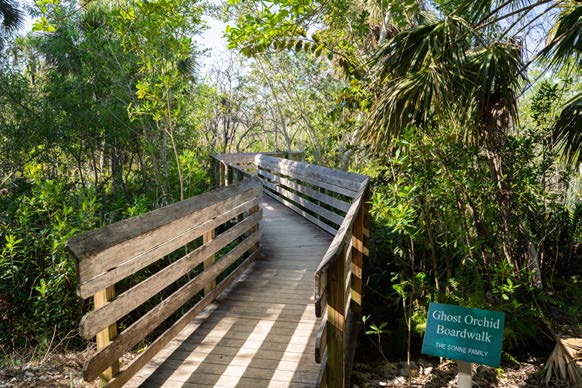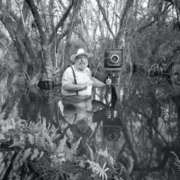Into the Woods
 Naples Botanical Garden is excited to host a new exhibition of photographer Clyde Butcher’s famed photographs of the Everglades. America’s Everglades: Through the Lens of Clyde Butcher, runs April 15–June 15.
Naples Botanical Garden is excited to host a new exhibition of photographer Clyde Butcher’s famed photographs of the Everglades. America’s Everglades: Through the Lens of Clyde Butcher, runs April 15–June 15.
In the spirit of celebrating South Florida’s wilderness, we take you to the Garden’s own bit of natural land where guests can step off the main pathway and into the woods. While there is a mile-long paved lakeside pathway popular with birders and walkers, the section of preserve discussed here is a short, unpaved stretch through pine uplands—a perfect introduction to woodsy explorations.
***
“Listen.” Eric Foht, the Natural Resources Director at Naples Botanical Garden, pauses and looks skyward. An osprey cries out, a high-pitched chirp that increases in urgency.
Foht oversees the 90 acres of native Southwest Florida habitat that comprise the Vicky C. and David Byron Smith Uplands Preserve and the Collier Enterprises South Wetland Preserve. He’s a perfect tour guide to this road-less-traveled portion of the Garden.
There are a few ways to access these natural areas; Foht chooses the entrance closest to the Smith Entry Prow. Walk toward the Kapnick Brazilian Garden, veer to the right at the Florida Uplands Preserve sign, and you’ll soon find yourself on the Sönne Family Ghost Orchid Boardwalk, enveloped in a pond apple slough.
 Look closely. If you visit in the summer, you may glimpse the rare ghost orchid in bloom. Regardless of season, you can see native orchids affixed to tree branches. Our staff grew and placed them here, their native habitat. (For a contrast, visit the LaGrippe Orchid Garden to see cultivated orchids arranged in dazzling displays).
Look closely. If you visit in the summer, you may glimpse the rare ghost orchid in bloom. Regardless of season, you can see native orchids affixed to tree branches. Our staff grew and placed them here, their native habitat. (For a contrast, visit the LaGrippe Orchid Garden to see cultivated orchids arranged in dazzling displays).
The boardwalk’s end is where Foht hears the osprey.
“I think one of the best ways to enjoy this area is to come out and listen to the silence. When you are quiet, you will hear the sounds around you,” he says.
The winds through the pines. The calls of the birds. Focus on your other senses, too. Notice the soft sand underfoot, the fragrance of pine needles, the glimmer of water in the distance.
In Florida, minute changes in elevation mean a big difference in plant life. Where the path splits, Foht turns to the right and enters a thicket of oaks. These are sand live oaks, somewhat different from the live oak trees frequently seen along roads and in yards.
“They have a cool growth form,” Foht observes. “They kind of twist and meander toward the sky.”
The path curves. Your shoes will sink into fine, white sand. Contrary to assumption, the Garden did not truck it in to pad the trail. Instead, it naturally occurs here, and the plants love it.
“You can’t see these plants just anywhere,” Foht says. “A lot of these plants only occur on these sand ridges.”
Peer into the brush, and you may spot something rare—giant air plants, Tillandsia utriculata, threatened by habitat loss and an invasive weevil. These Tillandsia are a type of bromeliad, the same family to which pineapples belong, in case you notice some similarities.
And while you look for these large plants, don’t ignore the diminutive ones, like the tiny wildflowers hugging the pathway.
“Even if you don’t know anything about the habitat, this is a nice place to walk,” Foht says. “If you like to journal, draw, write, take photos, this is a great spot to be.”
And if you want a secluded place to pursue those activities or simply daydream, you’ll find a rustic wood bench at the edge of the path, by the paved lake trail, beckoning you to do just that.
For information on hours, timed-ticketing policies, admission fees, and upcoming exhibitions and events, visit naplesgarden.org.




Leave a Reply
Want to join the discussion?Feel free to contribute!